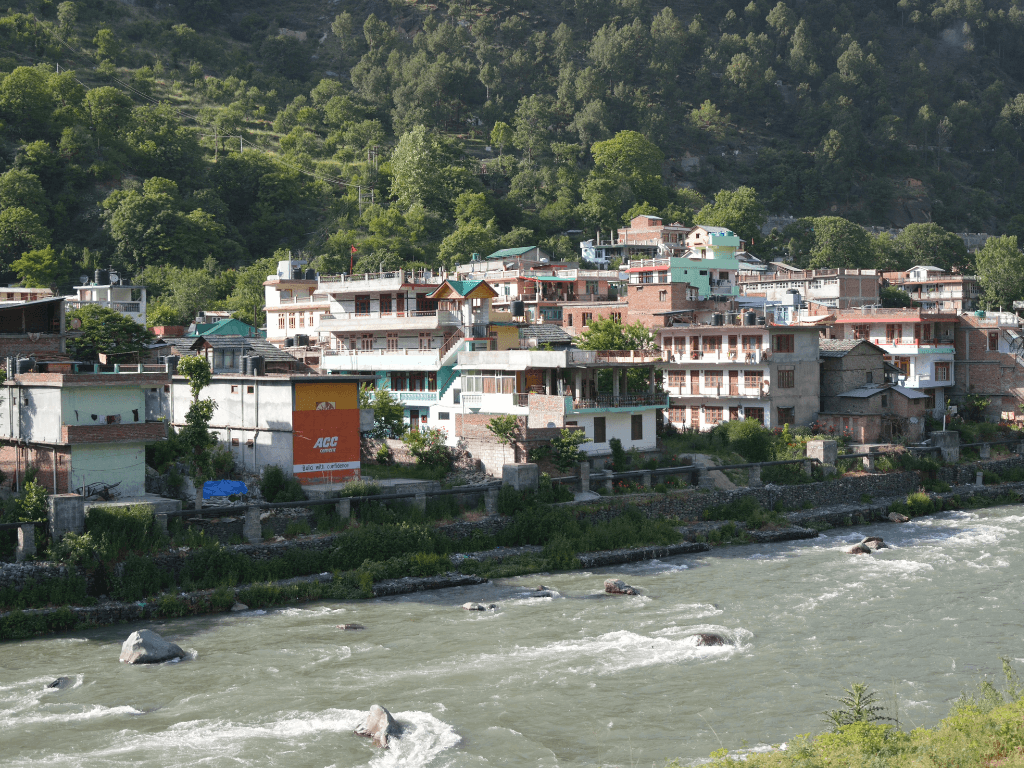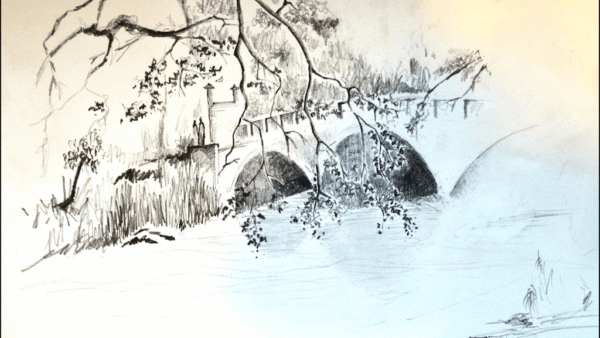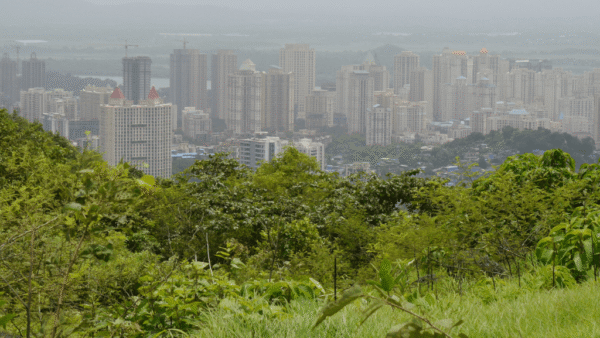One monsoon morning, under Kullu’s apple trees, I trailed behind a wiry man carrying an LPG cylinder up to a house in the clouds. By the time I caught my breath, my city friend looked at me in disbelief and asked: “Why live like this, hauling groceries for miles, sending your child hours to school, living so far from town?” The question makes sense in a world of smooth roads and two-minute Maggi. Yet, as the Dharali floods this year make painfully clear, what looks “easy” building along flat valley floors, can turn out most dangerous of all. The Bhagirathi, indifferent to convenience, claimed back its old path, sweeping away rows of new homestays, shops, and every plan that ignored its memory. (ISRO, 2025; Times of India, 2025)
ISRO’s images showed plainly that the river wiped away the latest experiment in “development,” validating the quiet wisdom of mountain families who built high, anchored not in optimism but in ancestral caution (Times of India, 2025).
In dozens of tea stalls in the Himalayas, I have heard complaints, a resort owner saying: “The river invades my property every year” and a geologist raising an eyebrow to say: “The river isn’t in your way. You’re in the way of the river.”
Here, humility is true seismic insurance. Forgetting is easy. The lure of quick profit tourism, roads, “green” projects seduce locals and outsiders alike. But true resilience has always meant honouring the river’s ancient choices (Chakrabarti, 2020). In the Himalayas, disaster is less a surprise than consequence, arising when memory and adaptation are traded for efficiency. Ask the people of Joshimath, where cracks now streak across living rooms, kitchens, and puja corners, fast becoming the town’s unofficial wallpaper. People joke about “designer homes, Himalayan style,” but the humour turns thin at night when families go to bed with one ear tuned for the sound of shifting earth. In the morning, it’s not just the plaster that’s unsettled, but everyone’s nerves. The mountain remembers every shortcut, even when development forgets.
Local knowledge as seismic architecture
What looks like rustic charm in Uttarakhand’s Koti Banal is precision engineering for earthquake country. Generations fit together timber and stone with astonishing skill, creating homes that flex with the earth rather than fight it. (Rautela & Joshi, 2017; BBC, 2022) Himachal’s Kath Kuni, Dhajji Dewari have different rhythms but same tune: A dialogue with risk, a memory in wood and stone. There’s more than physics embedded here but the skills and wisdom of generations of carvers are fading.

Photo: Wikimedia Commons
The big quakes of the 1990s ushered in a cement revolution. Suddenly, resilience meant concrete, and status meant permanence, no matter what the ground or grandmother said. (Times of India, 2019) Post-disaster missions papered with well-meaning terms like “resilient” favoured the quick fix of urban-centric building codes over the slow patience of tradition. Today, codes like the Indian Green Building Council (IGBC) for cities and big institutions, the Green Rating for Integrated Habitat Assessment (GRIHA) mandated for all new government buildings and used in large projects, and the State Action Plan on Climate Change are meant to make us safer. But they rarely draw on centuries of hard-earned local knowledge. (Manasi et al., 2021)
Instead, conservation copies the look, not the logic. Concrete mimics slate and timber, tile roofs fool the eye, but step inside and the house barely knows how to breathe. In Uttarakhand, concrete beams dressed up as wood are museum pieces, and ancestral wisdom is more performance than practice, admired but rarely trusted.
Caste, class, and the architecture of exclusion
Who decides who gets to step inside and who must remain at the threshold? In the Himalayas, caste quietly draws the boundaries. Dalits, often the region’s most skilled builders and carvers, complete beautiful homes but then linger outside, never truly invited in. I remember, at a festival, an eight-year-old drummer whose lineage is dedicated to playing for the village goddess, stood beaming in a drizzle, politely declining shelter. “I can’t be there didiji, I’m happy here.” Was he? What does belonging taste like, always on the edge?
Recent tragedies push the point. In Himachal, a Dalit child took his own life after being locked away for entering an upper-caste home. This spring in Uttarakhand, a Dalit couple was barred from their own temple wedding. In Almora, it was groups of young girls stopped before a shrine. Exclusion runs deeper than ritual; it structures every threshold. (NDTV, 2025; Hindustan Times, 2025; Indian Express, 2025)
Green codes are no better here. Though inclusive on paper, certifications cluster among the well networked, while the hamlets that know risk best remain outside, building what they can, waiting for a safety net that only seems to exist in brochures. (Manasi et al., 2021) Inclusion is a promise, exclusion a plan. Repeat until the next disaster.
The Himalayas taught me that exclusion is both a matter of place and of memory, alive in every stone threshold and in every silence. As an anthropologist, I sat with masons tallying the wounds of earthquakes in the beams of their homes, with women tracing rivers as both blessing and threat, and with children whose laughter echoed in the most precarious courtyards.

Photo: Wikimedia Commons
In the many boundaries I have walked between law and archaeology, between cities and mountain villages, between India and distant lands, beyond classrooms and field sites of UCLA, it was among the sharp valleys and whispered stories of Himachal and Uttarakhand that I found the deepest resonance. Cancer brought me into intimate conversation with vulnerability. Like villagers rebuilding after a disaster, I adapted, listening not only to my body but to others carrying stories, learning to honour the wisdom of those who survive at the margins.
Naming marginalisation
In the Himalayas, the landscape conceals an intricate architecture of exclusion, perpetuated over generations. Spatial boundaries are shaped not only by caste but also by the actual contours of mountains and valleys, with place names and the flow of water revealing persistent injustices. For instance, in Shimla, the area of Kachi Ghati, literally ‘Weak Valley’, stands as a coded marker – a flood-prone, landslide-risk locality where marginalised groups have long been pushed to settle. (Kachi Ghatti Locality – Shimla, 2025) The town’s privileged families inhabit Shimla’s highly valued, resilient centre while those at the edges face chronic instability and neglect.
A student of mine in Shimla once said something unforgettable: No matter how high you climb in education, if you are a Dalit, even your mountain will be separate. He spoke of his beautiful house in upper Shimla, perched on a hill, yet set apart from upper-caste settlements. It was a mountain both his and not, marked by quiet distance, a reminder that social geography is not overcome by academic degrees. Only overseas, did he first feel what it was to escape the clutches of generational casteism.
Nearby, Kullu’s towns and outlying villages follow similar logic. Settlements for marginalised groups are on the urban periphery, physically and socially separated from the economic core. (Sharma, 2023) Anthropological studies and oral histories describe generations of subtle exclusion, with locality boundaries inherited as silent codes for who belongs and who is left out. The layers of exclusion grow even more tangible in Naggar, where memory and water flow twist through daily life.
In Channalti, I have watched how the streams, that the community depends on, gather not just rain but the residue of those who live above, polluted water cascading, status travelling with the current. There, a few decades ago, a group of miniature temples surfaced as erosion peeled back the earth, uncovered by a low-caste farmer. According to local legend, there was once a temple to Shitala Mata until it was burned down and the idol was carried to Kullu. The priest there fervently denied its origins, tracing it instead to a distant Brahmin village in Haryana.

Photo: Wikimedia Commons
Alongside Shitala was another miniature temple dedicated to Shiva, the great equaliser. In the quiet stone courtyards of the temples, there is no priest and no prescribed ritual. All are free to worship however they choose; children collect coins offered by worshippers and happily spend them on candy. Economics and spirit entwine in this Dalit village. During the recent Kullu Dussehra, I became acutely aware that deities accompanied by low-caste entourages were quietly relegated to the festival’s periphery, distanced from the bustling core where status is privileged. Even in a divine congregation, the control of upper-caste custodians endures.
Such subtle marginalisation perpetuates itself across generations and carries forward from rural slopes into expanding urban neighbourhoods. Invisible locality boundaries and the logic of spatial exclusion act like an iron framework, one that is difficult to escape and rarely broken. Complaints to authorities and the police often go unresolved, as caste alliances still run deep.
These ongoing exclusions are not just ecological injustices, a matter of infrastructure and planning, but also insidious forms of spatialised violence. Gentrification and urban expansion have not erased these boundaries; rather, they often repackage old lines of caste and class in new patterns, reallocating the best land, greenest spaces, and cleanest water to the already privileged. Until such boundaries, etched in place names and the flows of water, are recognised and actively dismantled, justice and resilience in the Himalayas will remain brittle.
Land use, policy, and the colonial continuum
The Himalayan village, once mapped as a patchwork of shared fields, forests, and ridges, has become a playing field for investors, bureaucrats, and the latest policy experiments. The Forest Rights Act and Uttarakhand’s 2025 land law promise dignity and defense for locals but loopholes thrive. (Down to Earth, 2017) In just 20 years, over one lakh hectares of farmland have slipped from the hands of villagers, replaced by land speculation and construction meant for outsiders who rarely stay past Diwali. (Times of India, 2021)
Eco-sensitive zones, climate codes, and so-called “protected” landscapes, they all sound appealing, perfectly matched to environmental ideals on paper. In fact, many turn into gates for enclaves, or eco-resorts that exclude rather than include the people who once managed the land. (Lohani, 2024) In Dehradun, ‘Save the Ridge’ groups just can’t beat the bulldozers. Green hills turn into roads overnight.(Times of India, 2025)

Photo: Wikimedia Commons
Laws look strong on paper but are as hard to catch as a mountain cloud. In the end, money wins, justice loses. (TERI, 2015; Chopra, 2014) When a flood or landslide hits, new plans arrive in the hands of helpful consultants. But these blueprints are “pre-approved”, meaning they ignore the lived knowledge that once empowered communities to adapt, share risk, and decide their fate. Now, paperwork replaces partnership.
The way forward: Reclaiming justice through ecology
Uttarakhand will not reclaim its environmental balance unless it first restores social balance. The mountains teach, not just about earthquakes, codes, or vanishing traditions, but about the deep cracks where policy, caste, greed, and climate change all meet. (Chopra, 2014)
Patchwork code enforcement, rising caste inequity, profit’s hold on land, and the steady forgetting of local wisdom all have redrawn the boundaries of risk. Disaster recovery is more political and social than technical, and so-called resilience will always fail if exclusion stays intact.
Real change requires making caste justice the starting point rather than just a checkbox, recognising and using the best of traditional knowledge as a living resource, and giving genuine decision-making power back to local groups and panchayats instead of just offering consultation. There are no elegant shortcuts. The truth is carried by those who wait outside, the mason, the child, the family denied a voice in land or memory. True resilience is only possible when these voices shape the plan, not wait for it.

Photo: Wikimedia Commons
The Himalayan challenge is not just safer construction, but a healing of place and people. The mountains excel at adaptation; so must we. I think back to a mason I met in a remote village, quietly tapping at a deodar beam: “Pahad ki mitti bolti hai, didi. Agar dhyan se suno, sab samajh aa jaata hai” (Sister, the mountain soil speaks, only if you listen closely, you’ll understand everything). These days, real listening is drowned out by JCBs and planners in shiny boots.
Maybe all it takes is sitting with the people who have worked these hills for generations, hearing their stories, trusting their hands, and finally letting their wisdom guide what gets built and who gets welcomed home. Perhaps then, the mountains will still teach us resilience, bred of justice, memory, and the courage to invite everyone home. Until then, every tremor, each new code, and every flood is not just nature’s warning, but society’s unfinished question left at the threshold, for how long, we need to decide.
Dr Sonali Gupta, LL.B., Ph.D. (UCLA), is a lawyer and anthropological archaeologist recognised as India’s first Egyptologist. She is the Founder-Director of the Himalayan Institute of Cultural & Heritage Studies (www.hichs.org), Founding President of the Himalayan Conservation & Preservation Society (www.hcpsusa.org), and serves as a Consultant with ‘Communitology,’ a US-based organisation addressing issues of caste, gender discrimination, and climate-induced migration. She is on Instagram as @thehichs. This essay has stories braided from lives she has known besides her own, in the hope that a deeper understanding of justice, memory, and vulnerability may shape not only our cities but our most intimate landscapes.
Cover photo: Wikimedia Commons




